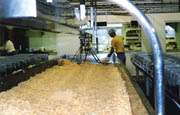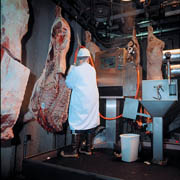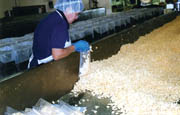
While many projects are underway to develop farm-to-fork traceability, the complexity of today's distribution system and the fragmentation of supply sources pose huge and, possibly, insurmountable challenges to identity preservation. Add in the need for better waste management, control of water use and growing consumer concerns about the nature of processed food, and the argument for localized sourcing and distribution grows stronger. To a large extent, consumer demand for greater accountability drives growth in natural and organic products: the nutritional content may be the same, but certified sourcing is a value more and more consumers are willing to pay a premium to get.
"Big farms will become regional factories," predicts Triveni Shukla, vice president of technology development at Mundelein, IL-based FiberGel Technologies Inc. "You can see that happening already. Most of the identity-preserved corn in Illinois is going directly to Japan at a five-cents-a-bushel premium. Farmers who are crying today that they're not making money will be growing and processing their own crops and finished goods on-site in the future."
Think small
Small and simple is replacing large and complex in many new-plant designs. On-farm processing is one reflection of this shift. Though still miniscule, farm-direct sales of agricultural products grew 37 percent from 1997 to 2002, with organic accounting for almost half the total, according to the USDA's 2002 Census of Agriculture. Estimating Frito-Lay could satisfy all its corn needs from 300,000 acres, Shukla says even the biggest food manufacturers could shift to localized sourcing and rationalize higher raw material costs with transportation savings and improved consumer perceptions. "There would be tactical advantages for the organic farmer with a Power Bar plant on his farm," he says. "You not only know the identity of the product, its organic status is much more certain."
But accounting for problems outside the four walls of the factory is another matter. Just as the complexity of a manufacturer's distribution system determines the difficulty of a recall, information on raw materials grows murky as their sourcing expands. The more localized the distribution, the easier problem resolution becomes, Sadowski says.
Sophisticated batch-control processes and other high-end technology won't be affordable for smaller plants, adds Rockwell's Charlie Rassle, but affordable controls architecture for a limited number of SKUs will enable regional processors to tap the labor savings potential of automation.
Dairy's ahead
"People want to know where their food comes from," says John Harrison, a Philadelphia, TN, dairy farmer who launched Sweetwater Valley Cheese in 1997. Sweetwater's combination processing facility-store draws its raw materials from the 700-head dairy herd on-site. Producing high-end cheddars and other cheeses gives Harrison an alternative sales channel in an increasingly consolidated dairy business. "Our initial goal was to use a third of our production for cheese, but we're stuck at about half that."
Several hundred miles northwest of Sweetwater Valley lies a facility similar in scale, though its cheesemaster and plant manager is reluctant to label his award-winning boutique cheeses "farmstead." "I don't milk the cows," laughs Randy Krahenbuhl, and for good reason: there are 15,000 of them at Fair Oaks Dairy Products LLC near Rensselaer, IN. The herd delivers 1 million lbs. of milk each day; on a good day, Krahenbuhl's crew could perhaps process 50,000 lbs. of it. Small scale doesn't preclude process sophistication, however: ultrafilitration, reverse-osmosis equipment and other technology are coming on-line at Fair Oaks to increase cheese yields, boost solids in ice cream mix and remove lactose from milk.
Fair Oaks' 20,000-sq. ft. plant and retail store are in the dairy's "Disneyworld part," as Krahenbuhl describes the agricultural theme park that opened on the farm last year. Equal parts brand-building and public education, the Fair Oaks Adventure Center is owner Mike McCloskey's attempt to rehabilitate big agriculture's image. "As our society has gotten farther from farming, people have lost touch with the industry and don't support it," says McCloskey, "so we invited people onto our farm to touch it and smell it." More than 10,000 people did just that in June, before a new off-ramp from I-65 opened and made visiting the farm easier.
No olfactory assault
Normally, the smell of 15,000 dairy cows would be more pungent than most Americans could stand, but Fair Oaks Dairy is no ordinary producer. A veterinarian himself, McCloskey employs three full-time vets, including one whose sole responsibility is the herd's comfort. Contented cows produce higher yields, it turns out, and the difference more than pays the salary of a medical professional. Managing the waste stream also can generate positive cash flow, and McCloskey has formed a partnership with Bion Environmental Technologies Inc. to process as much as 780,000 gallons of waste daily when the herd reaches 25,000. Besides slashing nutrient discharges by 75 percent and significantly reducing air emissions, the waste system will generate enough methane to produce 25 megawatts of electricity per day, making the dairy a seller of renewable energy to the electric grid.Often, public hostility to industrialization is cited as a factor in the dearth of US greenfield projects and the boom in manufacturing outsourcing to China and other countries. The food industry must respond with both "vertical and horizontal market integration," McCloskey argues, and waste treatment is part of the latter. "You have to integrate the waste streams in a positive way so by-products come back as feed for livestock, as power for boilers, as a source of electricity," he says. "All of a sudden you have a zero waste stream as part of an environmentally responsible plant."
Integration everywhere
Vertical and horizontal integration is in full-flower in another McCloskey project: Southwest Cheese Company LLC, the $200 million processing facility nearing completion in Clovis, NM. Select Milk, a milk-producer cooperative headed by McCloskey, has an ownership position and will be a key raw-material supplier to the plant, which will process up to 7 million lbs. of raw milk a day. DFA, the nation's largest dairy cooperative, is another owner/supplier. Twin Falls, Idaho-based Glanbia Foods Inc. has 50 percent ownership and will run the operation.Southwest Cheese will produce cheddar and some Monterey cheeses in 640-lb. blocks. An annual output of more than 250 million lbs. of cheese and 16.5 million lbs. of value-added whey proteins will place it among the largest cheese plants in the nation. But sheer volume isn't Southwest's only distinction: the key is production of finished goods with a higher value. For example, Glanbia uses a chromatography separation process to harvest bio-active lactoferrin from whey protein, avoiding destructive thermal processes. And while mass-produced cheddar falls short of an artisan cheese or even the farmstead-style produced at his Indiana farm, McCloskey says Southwest's product is a step above. "Fast-food chains are demanding higher quality cheese," he maintains. If American cheese consumption is going to grow, better cheeses at every level will have to be produced, he believes.
Southwest's partnership approach doesn't end with the producer-processor alliance. Two animal feed suppliers are building facilities adjacent to the cheese plant to squeeze more value from the waste stream. Mesa Ingredients Co. is investing $15 million to process half the permeate Glanbia can't use into a powder for hog feed. Westway Feed Products will deal with the rest in a $1 million terminal to partially concentrate whey for production of a molasses-like livestock feed.
Although McCloskey declines to address the upfront costs of horizontal integration, increased efficiency clearly requires higher initial capitalization. Today's business model is based on reducing equipment costs, not increasing them. If Southwest Cheese represents the wave of the future, the interdependent relationships being forged in the New Mexico desert will be a critical part of the capitalization equation.
End of obsolescence
Beefier equipment may be another new plant imperative. With senior maintenance engineers heading for the retirement door in droves and few young workers available to replace them, food companies will have to bite the capital bullet or face huge productivity losses when key pieces of machinery fail."Processors can't afford to keep using toy machines," declares Tom Wooley, a mechanical engineer with Beef Products Inc., Dakota Dunes, SD. Equipment designed for extended service is needed if manufacturers are to meet product quality and output demands. Simply put, machines that run eight hours a day are passé; more robust designs are required if lines are to run 24/7.
A processor of lean ground beef from trimmings, BPI recently branched into building and marketing the kinds of heavy-duty machines it designs for its own four plants, including massive pumps, contact-freezing systems and other specialty equipment. Engineering drawings and specifications used to be turned over to fabricators, but last year, the company's own machine shop opened adjacent to the BPI South Sioux City, NE, facility (see "Innovation Incubator, Food Engineering, February 2004). Doing business as Freezing Machines Inc., the shop is producing a wide range of food processing equipment. In terms of sheer tonnage, the most impressive are the grinding, blending and pumping systems being installed at 71 hamburger-patty suppliers to a major quick-serve chain worldwide.
New alloys, heat-treatment processes and other advances in metallurgy are being used in component manufacture to extend time to failure well beyond industry standards, Wooley explains. "Right now, most of the seals used in these types of systems fail in a matter of days. We're chasing a lifetime sanitary seal."
Orders for meat grinding/blending systems are few and far between, he adds, forcing fabricators to rely on replacement parts to sustain their businesses. BPI founder Eldon Roth rejected that business model for his own firm, and his machine shop is bringing his built-for-life goal to other processors. While daily knife changes sometimes are required on conventional units, in BPI's first grinding/blending/pumping installation, plates and knives were running 45 days without change, Wooley reports.
Maintaining productivity in the future
Whether maintenance occurs daily or monthly, equipment requires servicing, and the skill levels of new maintenance workers pose a threat to future plants' productivity. "Outsourcing maintenance will be one of the trends of the future," predicts Dragan Filipovic, associate principal scientist at Kraft Foods' R&D center in Glenview, IL. That will further aggravate the maintenance training and knowledge gap, which is why Filipovic is developing "augmented reality" tools such as VGST (visually guided servicing & training) goggles to guide maintenance workers unfamiliar with a particular machine. VGST goggles present two images: how equipment's moving parts should look and how they actually look. If deviations exist, a video clip detailing repair procedures is played on the goggles' monitor to guide the worker. VGST goggles also will play a role in precision changeovers to help production lines reach optimal efficiency in the first hour, rather than the 30 to 40 percent efficiency rates now common in food plants, he adds.Filipovic says a VGST system codeveloped with Siemens at a cost of $10,000 was successfully tested in a Kraft facility. While some may see this as an attempt to dumb-down maintenance, Filipovic argues it will improve the current state of affairs, in which a push-button "tractor mentality" creates extended and costly downtime because maintenance resources already are stretched too thin to correct problems quickly.
Advanced diagnostics at Kraft is even farther along, says Filipovic. Root-cause video capture of machine disruptions began two years ago with a PMI cartoner in a downstate Illinois facility producing boxes of EasyMac. Two cameras capture machine-state images every 10 milliseconds in the 10 seconds leading up to a machine disturbance. The image are paired with data from 256 digital I/Os to allow precise diagnosis of the problem. Dubbed Remote Observer of Manufacturing Equipment (ROME), the technology will be licensed to other food manufacturers through PercepTek Inc., a Littleton, CO, defense contractor.
Projects like ROME are part of the new frontier in controls technology for food plants. The analytics may be advanced, but the goal is simple - leverage the data in PLCs, drives and other devices into useful operator and supervisor information. One of the most potent uses of this information is in reshaping the supply chain.
In the past, supply chain initiatives had limited impact on what went on within the four walls of the plant. The production process remained independent of supply chain demands because there was no way to link the decisions being made with the actions in the plant, argues Mark Grace, president of Atlanta-based BeyondVia LLC, a decision-support firm he recently launched. But now, supply chain relationships are evolving from simple accept/reject decisions based on a few QA-related measurements into shared information on hundreds of measurements that define the product. "Information is part of the product and needs to flow with it through the supply chain," says Grace. Information derives from real-time data that is graphically presented in a format plant managers can understand and react to for continuous improvement. "Highest quality at the most economical price is a given, but the supply chain also is asking for more customized and differentiated products," he says. "By capturing data and delivering it to managers in an understandable format, manufacturers can customize products as they're made, rather than checking lots after they've been produced."
How green was my factory
In the face of an uncertain future, how are food manufacturers responding? Greenfield projects and expansions of manufacturing plants have plummeted to 2 percent of US nonresidential construction, down from 10 percent in 1980. The largest food and beverage processors are more apt to shutter obsolete facilities than build dynamic, new ones. "Everybody is looking at adding an extra processing step to get more money per pound of product," says Chuck Pharr, a principal in Vaughn, Coltrane, Pharr & Associates, "but we're not seeing people putting in plants as ambitious as FBO."The ill-starred FBO (Future Beef Operations) plant in Arkansas City, KS, had ambitions that exceeded the depths of its pockets. Determined to remake the beef segment by returning quality data to suppliers so they could improve their livestock, FBO's owners incorporated unprecedented value-added processing into their facility. Besides a packinghouse and further-processing area, the building included a tannery and a pet-products operation to turn byproducts worth pennies per pound into chew toys that fetched dollars per item at retail. FBO's founders were frustrated former managers within some of the industry's biggest companies who struck out on their own to try innovative new approaches. A consulting engineer on the project, Pharr helped implement a dehairing process that minimized the bacteria carried into the plant on the hides of cattle.
"I don't know if beef processors are losing consumer credibility, but clearly, companies are trying to respond to concerns on the genetics side and provide products consumers can have greater confidence in," says Pharr. "FBO was a harbinger of greater accountability of the DNA of animals and the way they are processed."
Higher value comes at a higher cost, and Pharr believes Safeway Stores' reluctance to charge more for the added value of FBO's products doomed the operation. On the other hand, if fast-food chains are prepared to pay a premium for cheddar cheese, there's hope mainstream processors will crack the premium segment now dominated by organics. "We're getting ready to pay $3 a gallon for gas," Pharr muses. "Maybe people are willing to pay 50 cents more for a McDonald's hamburger."
Closer public scrutiny of food and the companies that produce it also is driving greater environmental stewardship. Better waste handling processes are part of the change, though the green trend goes much deeper. "The food industry has always held a prominent role in the communities where they have manufacturing facilities," points out Darryl Wernimont, an engineer with the Haskell Co. If future food facilities are to short-circuit the not-in-my-back-yard opposition that curtails new-plant construction in other industries, they will have to be built to the higher energy and environmental standards of groups such as the US Green Building Council, Wernimont believes. "Green is a growing trend," he says, "and a trend that is here to stay." In response, an increasing number of Haskell design/build projects embrace sustainable design features.
For half a century, the US food industry pursued the goal of the most food at the least cost, and its plants delivered on that goal. But today's market is less price-sensitive and more fragmented. Many Americans are displaying a willingness to pay more to get more. It's a different target than the price-sensitive consumers who have made Wal-Mart the world's largest grocery store, and it's an opportunity for the entrepreneurs who are bringing a new breed of processing facilities on-line to serve those customers.
For more information:
Mark Grace, BeyondVia,
678-595-6760,
markgrace@beyondvia.com
Mike Cunningham, Freezing Machines Inc.,
712-899-6044
Darryl Wernimont, the Haskell Co.,
904-357-4820,
darryl.wernimont@thehaskelco.com
Steven Paulet, PercepTek Inc.,
720-344-1037,
steven.paulet@perceptek-robotics.com
Randy Sadowski, Rockwell Automation,
724-743-3521
Chuck Pharr, Vaughn, Coltrane, Pharr & Associates,
479-756-0007